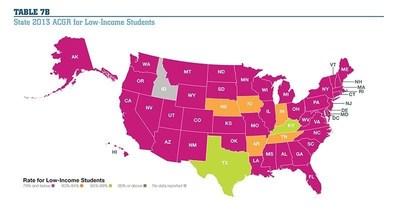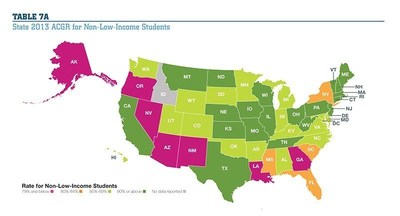WASHINGTON, May 12, 2015 /PRNewswire-HISPANIC PR WIRE/ — For the third year in a row, the country remains on pace to achieve the national goal of a 90 percent on-time high school graduation rate by 2020, according to the 2015 Building a Grad Nation report released today by America’s Promise Alliance, Civic Enterprises, Everyone Graduates Center, and the Alliance for Excellent Education.
The GradNation campaign’s sixth annual update on progress and challenges in increasing high school graduation rates shows that the country hit a record high of 81.4 percent in 2013, based on the most recent comprehensive data available from the National Center for Education Statistics at the U.S. Department of Education.
As a result of progress made over the last decade, 1.8 million additional students have graduated from high school. To reach 90 percent, the graduating class of 2020 will need to have 310,000 more graduates than the Class of 2013.
At the state level, progress was driven by significant gains in some of the 10 largest states, including California, Florida, Georgia and North Carolina. But future gains are threatened by declining or stagnating graduation rates in New York, Illinois, Washington and Arizona, which together educate 15 percent of the nation’s high school students.
New analysis of district-level data shows that some districts are making tremendous progress while others are lagging or even going backwards. Much of the recent gain has been driven by one-quarter of the nation’s 500 largest school districts (districts that educate 15,000 or more students) which have been able to rapidly improve their graduation rates. Between 2011 and 2013, 124 of the 500 largest districts saw improvement of more than three times the national average. The majority of the students in these districts were students of color and low-income.

Low-income students. New data and analysis in the report show that the national graduation rate for middle/high-income students is at 88.2 percent, almost 15 percentage points higher than the rate for low-income students. The half of the student population that is middle or high income is very close to reaching the 90 percent goal, while the half that is low income is still far away. In 16 states, 90 percent of middle/high-income students already graduate; in 11 states less than 70 percent of low-income students graduate.
Students of Color. Nationally, Hispanic/Latino and African American students are starting to close the graduation gap with their white peers. Hispanic/Latino students—the fastest growing population of students—have made the greatest gains in the Adjusted Cohort Graduating Rate* reporting data, improving 4.2 percentage points to 75.2 percent in 2013. African American students have risen 3.7 percentage points, from 67 percent in 2011 to 70.7 percent in 2013.
Seven states – Michigan, New York, Ohio, Georgia, Florida, California and Illinois – educate about 40 percent of the nation’s African American students. Unless these states start to experience significant improvements, the recent progress made in raising African American graduation rates will stall.
One reason for the national improvement in graduation rates among students of color is the decline in high schools with low graduation rates, often referred to as “dropout factories.” While there were 2,000 such schools in 2002, there were fewer than 1,200 of these schools nationwide and 1.5 million fewer students attending them in 2013.
Roadblocks to graduation for students of color include: “toxic stress” from living in high-poverty neighborhoods; a rise in exclusionary discipline practices, particularly in secondary schools; disparities in academic opportunities, such as access to challenging classes and coursework that will help to prepare students for college and career; as well as lack of support for English language learners.

Students with disabilities. Students with disabilities graduating on time reached 61.9 percent in 2012-13, compared to the 84.1 percent national graduation rate for general population students. This is an increase of 2.9 percentage points since 2010-11, but almost 20 points behind the national average. Estimates show that the graduation rate gap between students with disabilities and students in the general population ranges widely across states from 3.3 percentage points to 58.8 points. State variations of ACGR data, coupled with variation in state allowances for special education guidelines, contribute to the disparities keeping special education students from reaching their full potential.
Recommendations. The report includes several recommendations for how federal, state and district policymakers can help more students graduate from high school. Some of those recommendations include eradicating zero-tolerance discipline policies, expanding the use of early warning systems, making state funding more equitable, and increasing the use of consistent and comparable data to hold states accountable.
Full press release, report and graphics. To read the full press release and a copy of the 2015 report, including state and subgroup numbers, and to download graphics visit: www.GradNation.org/GradReport. The GradNation campaign, led by America’s Promise, seeks to raise the national on-time graduation rate to 90 percent by 2020 and increase postsecondary enrollment and completion.
About the Building a Grad Nation Report. The 2015 Building a Grad Nation: Progress and Challenge in Ending the High School Dropout Epidemic report is co-authored by John Bridgeland, Jennifer DePaoli and Erin Ingram of Civic Enterprises and Robert Balfanz, Joanna Hornig Fox and Mary Maushard at the Everyone Graduates Center at Johns Hopkins University School of Education in partnership with John Gomperts and his team at America’s Promise and Bob Wise and his team at the Alliance for Excellent Education. The 2015 report is presented by lead sponsor AT&T, with supporting sponsorship from Target.
*The ACGR or Adjusted Cohort Graduation Rate is a newer metric now used by all states and school districts for tracking a group (or cohort) of students who enter high school together, as first-time ninth graders (or tenth graders) and graduate on-time with a regular diploma.
Daria L. Hall
America’s Promise Alliance
202.657.0621/718.404.7448
dariah@americaspromise.org
Kathleen McMahon
Civic Enterprises
703-868-6981
kmcmahon@civicenterprises.net
Mary Maushard
Everyone Graduates Center
410.516.8810
mmaushard@jhu.edu
Jason Amos
Alliance for Excellent Education
202.828.0828
jamos@all4ed.org
Photo – http://photos.prnewswire.com/prnh/20150512/215313-INFO
Photo – http://photos.prnewswire.com/prnh/20150512/215312-INFO
